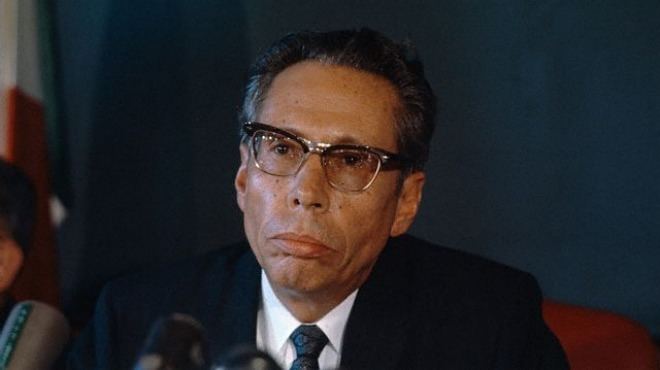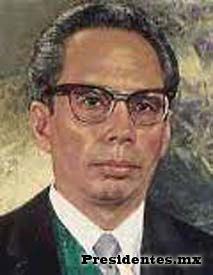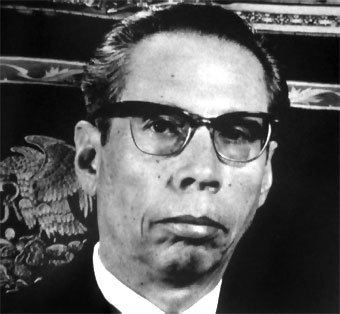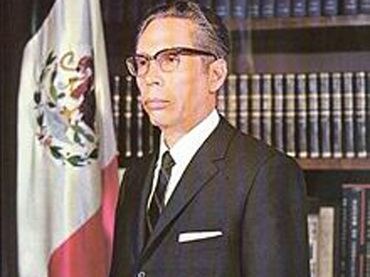Preceded by Adolfo Lopez Mateos Name Gustavo Ordaz Preceded by Carlos I. Betancourt Role Mexican Politician | Nationality Mexican Succeeded by Luis Echeverria | |
 | ||
Full Name Gustavo Diaz Ordaz Bolanos Presidential term December 1, 1964 – November 30, 1970 Education Benemerita Universidad Autonoma de Puebla (1937) Children Gustavo Diaz Ordaz Borja, Alfredo Diaz Ordaz Borja, Guadalupe Diaz Ordaz Borja Similar People Luis Echeverria, Adolfo Lopez Mateos, Adolfo Ruiz Cortines, Jose Lopez Portillo y Pacheco, Manuel Avila Camacho | ||
PRESIDENT JOHNSON IN MEXICO - NO SOUND
Gustavo Díaz Ordaz Bolaños ([gusˈtaβo ˈðiaθ orˈðaθ]; 12 March 1911 – 15 July 1979) was a Mexican politician and member of the Institutional Revolutionary Party (PRI). He served as the President of Mexico from 1964 to 1970.
Contents
- PRESIDENT JOHNSON IN MEXICO NO SOUND
- Entrevistas a gustavo diaz ordaz en 1970 y 1977 01 de 02
- Early life and education
- Early political career
- Domestic policy
- Student movement
- Attempt to democratize the PRI
- United States
- Treaty of Tlatelolco
- Later life
- References

Entrevistas a gustavo diaz ordaz en 1970 y 1977 01 de 02
Early life and education

Díaz Ordaz Bolaños was born in San Andrés Chalchicomula (now Ciudad Serdán, Puebla). His father, Ramón Díaz Ordaz Redonet, worked as an accountant. His mother, Sabina Bolaños Cacho de Díaz Ordaz, worked as a school teacher.

Díaz Ordaz graduated from the University of Puebla on 8 February 1937 with a law degree. He became a professor at the university and served as vice-rector from 1940 to 1941.
Early political career

In 1943, he became a federal deputy for the first district of the state of Puebla, and he served as a senator for the same state from 1946 to 1952. He served as the Secretary of Government in the cabinet of President Adolfo López Mateos from 1958 to 1964. On 18 November 1963, he became the presidential candidate for the Institutional Revolutionary Party (PRI). Despite facing only token opposition, Díaz Ordaz campaigned as if he were the underdog. He won the presidential election on 5 July 1964.
Domestic policy

As president, Díaz Ordaz was known for his authoritarian manner of rule over his cabinet and the country in general. His strictness was evident in his handling of a number of protests during his term, in which railroad workers, teachers, and doctors were fired for taking industrial action. A first demonstration of this new authoritarianism was given when he used force to end a strike by medics. Medics of the Institute for Social Security and Services for State Workers, especially residents and interns, had organized a strike to demand better working conditions and an increased salary. His authoritarian style of governing produced resistance such as the emergence of a guerrilla movement in the state of Guerrero. Economically, the era of Díaz Ordaz was a time of economic growth. He established the Mexican Institute of Petroleum in 1965, an important step since oil has been one of Mexico's most productive industries.
Student movement
When university students in Mexico City protested the government's actions around the time of the 1968 Summer Olympics, Díaz Ordaz oversaw the occupation of the National Autonomous University of Mexico and the arrest of several students, leading to the shooting of hundreds of unarmed protesters during the Tlatelolco massacre in Downtown Mexico City on 2 October 1968. The Mexican army fired ruthlessly because a group called "Battalion Olympia" started the shooting between the unarmed students and many other people who let the students take shelter inside their homes. Statistics concerning the casualties of this incident vary, often for political reasons. Some people were kept imprisoned for several years. The crackdown would eventually be denounced by Díaz Ordaz's successors, and ordinary Mexicans view the assault on unarmed students as an atrocity. The stain would remain on the PR for many years.

Every year, on the anniversary of the Tlatelolco massacre, the statue of Díaz Ordaz in Zapopan, Jalisco, is vandalized by having a bucket of red paint splattered on it.
Attempt to democratize the PRI
Díaz Ordaz's authoritarian manner of rule also prevented any attempt to democratize the PRI. The president of the PRI, Carlos Madrazo, made such an attempt by proposing inner-party elections in order to strengthen the party's base. After his attempt failed, Madrazo resigned.
United States
During the administration of Díaz Ordaz, relations with the US were largely harmonic, and several bilateral treaties were formed. President Richard Nixon hosted the first White House state dinner to be held outside Washington, D.C. in Diaz Ordaz's honor, at San Diego's Hotel del Coronado on September 3, 1970.
However, there also were some points of conflict with the US. One was the antidrug Operation Intercept, conducted by the US. Between September and October 1969, all vehicles entering the US from Mexico were inspected. Mexico also embraced the doctrine of nonintervention, and Díaz Ordaz condemned the US invasion of Santo Domingo, the capital of the Dominican Republic.
Treaty of Tlatelolco
Under his administration, the Treaty of Tlatelolco prohibited the production, possession, or use of nuclear weapons in Latin America. Only peaceful use of nuclear energy was allowed. The treaty made Latin America a nuclear weapon-free zone.
Later life
After his term expired, Díaz Ordaz and his family vanished completely from the public eye; he was occasionally mentioned in newspapers (usually in a derogatory manner), he seldom gave interviews, and he was usually spotted only when voting in elections.
In 1977, a break from that obscurity came as he was appointed as the first Ambassador to Spain in 38 years, relations between the two countries having previously been broken by the triumph of Falangism in the Spanish Civil War. During his brief stint as Ambassador, he met with a lot of hostility from both the Spanish media and the Mexican media, as he was persistently asked questions about his actions as President. He resigned within several months because of that and his health problems. Popular discontent led to a catchy phrase: "Al pueblo de España no le manden esa araña" ("To the people of Spain, do not send that spider").
He died in Mexico City of colorectal cancer.
